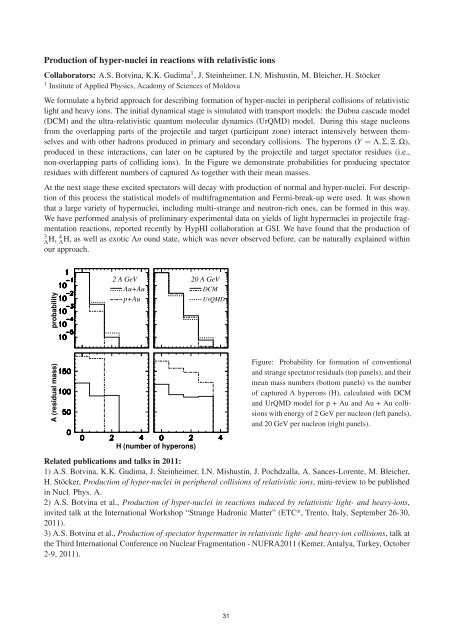FIAS Scientific Report 2011 - Frankfurt Institute for Advanced Studies ...
FIAS Scientific Report 2011 - Frankfurt Institute for Advanced Studies ...
FIAS Scientific Report 2011 - Frankfurt Institute for Advanced Studies ...
Create successful ePaper yourself
Turn your PDF publications into a flip-book with our unique Google optimized e-Paper software.
Production of hyper-nuclei in reactions with relativistic ions<br />
Collaborators: A.S. Botvina, K.K. Gudima 1 , J. Steinheimer, I.N. Mishustin, M. Bleicher, H. Stöcker<br />
1 <strong>Institute</strong> of Applied Physics, Academy of Sciences of Moldova<br />
We <strong>for</strong>mulate a hybrid approach <strong>for</strong> describing <strong>for</strong>mation of hyper-nuclei in peripheral collisions of relativistic<br />
light and heavy ions. The initial dynamical stage is simulated with transport models: the Dubna cascade model<br />
(DCM) and the ultra-relativistic quantum molecular dynamics (UrQMD) model. During this stage nucleons<br />
from the overlapping parts of the projectile and target (participant zone) interact intensively between themselves<br />
and with other hadrons produced in primary and secondary collisions. The hyperons (Y = Λ,Σ,Ξ,Ω),<br />
produced in these interactions, can later on be captured by the projectile and target spectator residues (i.e.,<br />
non-overlapping parts of colliding ions). In the Figure we demonstrate probabilities <strong>for</strong> producing spectator<br />
residues with different numbers of captured Λs together with their mean masses.<br />
At the next stage these excited spectators will decay with production of normal and hyper-nuclei. For description<br />
of this process the statistical models of multifragmentation and Fermi-break-up were used. It was shown<br />
that a large variety of hypernuclei, including multi-strange and neutron-rich ones, can be <strong>for</strong>med in this way.<br />
We have per<strong>for</strong>med analysis of preliminary experimental data on yields of light hypernuclei in projectile fragmentation<br />
reactions, reported recently by HypHI collaboration at GSI. We have found that the production of<br />
3<br />
ΛH, 4 ΛH, as well as exotic Λn ound state, which was never observed be<strong>for</strong>e, can be naturally explained within<br />
our approach.<br />
probability<br />
A (residual mass)<br />
2 A GeV<br />
Au+Au<br />
p+Au<br />
H (number of hyperons)<br />
20 A GeV<br />
DCM<br />
UrQMD<br />
Figure: Probability <strong>for</strong> <strong>for</strong>mation of conventional<br />
and strange spectator residuals (top panels), and their<br />
mean mass numbers (bottom panels) vs the number<br />
of captured Λ hyperons (H), calculated with DCM<br />
and UrQMD model <strong>for</strong> p + Au and Au + Au collisions<br />
with energy of 2 GeV per nucleon (left panels),<br />
and 20 GeV per nucleon (right panels).<br />
Related publications and talks in <strong>2011</strong>:<br />
1) A.S. Botvina, K.K. Gudima, J. Steinheimer, I.N. Mishustin, J. Pochdzalla, A. Sances-Lorente, M. Bleicher,<br />
H. Stöcker, Production of hyper-nuclei in peripheral collisions of relativistic ions, mini-review to be published<br />
in Nucl. Phys. A.<br />
2) A.S. Botvina et al., Production of hyper-nuclei in reactions induced by relativistic light- and heavy-ions,<br />
invited talk at the International Workshop “Strange Hadronic Matter” (ETC*, Trento, Italy, September 26-30,<br />
<strong>2011</strong>).<br />
3) A.S. Botvina et al., Production of spectator hypermatter in relativistic light- and heavy-ion collisions, talk at<br />
the Third International Conference on Nuclear Fragmentation - NUFRA<strong>2011</strong> (Kemer, Antalya, Turkey, October<br />
2-9, <strong>2011</strong>).<br />
31
















